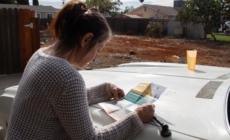-
Authorities raid 45-ton, $100-million marijuana stash in California - 16 mins ago
-
Is Luigi Mangione Getting Fan Mail in Jail? - 23 mins ago
-
Let’s Talk About Pornography. No, Seriously. - 24 mins ago
-
7.0 quake prompts endangered Death Valley fish species to get busy - 57 mins ago
-
Red Sox Reportedly In Talks With Orioles All-Star Free Agent Hurler - 58 mins ago
-
A Message for Girls About Womanhood - about 1 hour ago
-
Americans Have Three Day Deadline to Make Urgent Health Insurance Decision - 2 hours ago
-
Water agency board member censured for racist remark - 2 hours ago
-
Minnesota and New Jersey Sue Glock Over Lethal Add-On for Guns - 2 hours ago
-
Dueling Cats Captivate Internet: ‘A Cinematic Masterpiece’ - 2 hours ago
Nuclear Bomb Map Shows How US, Russian, North Korean Weapons Compare
There is currently a lot of talk about nuclear war as conflict escalates between the United States and its NATO allies with Russia over its ongoing war in Ukraine.
The Russia-Ukraine war has raged on for more than two years after Russian President Vladimir Putin ordered the “special military operation” in Ukraine in February 2022. Although Moscow aimed for a quick victory over its Eastern European neighbor, viewed as having a much smaller military, its spirited defense effort bolstered by the U.S. and its NATO allies, has blocked it from making substantial gains.
Putin recently signed an updated nuclear doctrine into law that emphasizes that Moscow will make “all necessary efforts to reduce the nuclear threat” and aims to prevent escalating tensions between states that could lead to “military conflicts, including nuclear ones.”
It also says that nuclear deterrence should also ensure “an understanding by a potential adversary of the inevitability of retaliation in the event of aggression against the Russian Federation and (or) its allies.”
Ukraine used U.S.-made ATACMS missiles against a target inside Russia for the first time last month after President Joe Biden allowed such usage. This followed Moscow’s deployment of North Korean troops to the front lines in the Kursk region, an action described by the Biden administration as a significant escalation of the conflict.
On Tuesday, Dmitry Medvedev, the deputy chairman of the Security Council of Russia and former Russian president, said the U.S. was “seriously discussing the consequences of transferring nuclear weapons to Kyiv,” however the White House told Newsweek that it is “not planning to equip Ukraine with nuclear weapons.”
Meanwhile, Newsweek has compared how different countries’ nuclear weapons compare, by using maps produced by Alex Wellerstein, a professor and historian of nuclear technology, to assess what the impact would be if a nation launched its nuclear weapon on New York.
The maps show the fireball radius (inner yellow circle), in which everything would be vaporized by intense heat rising to millions of degrees Fahrenheit and the more moderate blast damage radius (inner gray circle), which would destroy residential buildings and probably cause widespread fires.
It also covers the thermal radiation radius (wider orange circle), in which people would be at risk of suffering third-degree burns throughout the skin “often painless because they destroy the pain nerves,” which can cause severe scarring, disablement and require amputation.
In the light blast radius, glass windows are expected to break, resulting in many injuries.
Some simulations show results for the radiation radius, where the radiation dose would likely be fatal with around 15 percent of survivors dying of cancer within a month of exposure.
The simulation for Russia’s Tsar Bomba also showed the heavy blast damage radius, where heavily built concrete buildings would be damaged or demolished and deaths would reach 100 percent.
Newsweek has looked at the impact of Russian weapons on U.S. cities here and NATO capitals here.
U.S. Castle Bravo
In any given 24-hour period, there are on average 15,586,881 people in the light (1 psi) blast range of the simulated detonation of the U.S.’s Castle Bravo (the largest U.S. bomb ever tested, yielding 15,000 kilotons) launched on New York.
Deaths: 4,952,580
Injuries: 5,433,290
Fireball radius: 12 square miles
Moderate blast damage radius: 365 square miles
Thermal radiation radius: 24.3 square miles
Light blast damage radius: 2,880 square miles
Detonation altitude: 25,270 ft. (Chosen to maximize the 5 psi range.)

Russia’s Tsar Bomba
In any given 24-hour period, there are on average 16,338,222 people in the light (1 psi) blast range of the simulated detonation of Russia’s Tsar Bomba (the largest USSR bomb ever tested, yielding 50,000 kilotons).
Deaths: 7,633,390
Injuries: 4,194,990
Radiation radius (fatal radiation dose): 11.9 square miles
Fireball radius: 32.3 square miles
Heavy blast damage radius (where heavily built concrete buildings are severely damaged or demolished and casualties approach 100 percent): 96.2 square miles
Moderate blast damage radius: 522 square miles
Thermal radiation radius: 522 square miles
Light blast damage radius: 3,580 square miles
Detonation altitude: 13,000 ft.

NUKEMAP
North Korean weapon tested in 2017
In any given 24-hour period, there are on average 4,508,510 people in the light (1 psi) blast range of the simulated detonation of the North Korean weapon tested in 2017 (which yields 150 kilotons), launched in New York.
Deaths: 728,220
Injuries: 1,562,410
Fireball radius: 0.3 square miles
Radiation radius: 1.22 square miles
Moderate blast damage radius: 16.9 square miles
Thermal radiation radius: 33.5 square miles
Light blast damage radius: 134 square miles
Detonation altitude: 5,440 ft.

NUKEMAP
China’s Dong-Feng 5
In any given 24-hour period, there are on average 12,867,816 people in the light (1 psi) blast range of the simulated detonation of China’s Dong-Feng 5 (which yields 5,000 kilotons).
Deaths: 3,245,840
Injuries: 4,654,310
Fireball radius: 4.96 square miles
Moderate blast damage radius: 175 square miles
Thermal radiation radius: 15.2 square miles
Light blast damage radius: 1,390 square miles
Detonation altitude: 17,520 ft.

NUKEMAP
United Kingdom’s Mk4A/Holbrook
In any given 24-hour period, there are on average 3,825,912 people in the light (1 psi) blast range of the simulated detonation of the U.K.’s Mk4A/Holbrook warhead (which yields 100 kilotons) being launched on New York.
Deaths: 583,160
Injuries: 1,337,780
Fireball radius:0.22 square miles
Moderate blast damage radius: 1.49 square miles
Thermal radiation radius: 12.9 square miles
Light blast damage radius: 2.72 square miles
Detonation altitude: 4,760 ft.

NUKEMAP
France’s TN 80/81
In any given 24-hour period, there are on average 5,878,536 people in the light (1 psi) blast range of the simulated detonation of France’s TN 80/81 (which yields 300 kilotons) being launched on New York.
Deaths: 1,039,840
Injuries: 2,024,010
Radiation radius: 0.26 square miles
Fireball radius: 0.52 square miles
Moderate blast damage radius: 26.9 square miles
Thermal radiation radius: 62.3 square miles
Light blast damage radius: 212 square miles
Detonation altitude: 6,860 ft.

NUKEMAP
India’s largest weapon ever tested
In any given 24-hour period, there are on average 3,125,839 people in the light (1 psi) blast range of the simulated detonation of India’s largest weapon ever tested (60 kilotons) being launched in New York.
Deaths: 460,540
Injuries: 1,098,780
Fireball radius: 0.14 square miles
Radiation radius: 1.63 square miles
Moderate blast damage radius: 9.19 square miles
Thermal radiation radius: 14.7 square miles
Light blast damage radius: 72.7 square miles
Detonation altitude: 4,010 ft.

NUKEMAP
Pakistan’s largest weapon ever tested
In any given 24-hour period, there are on average 2,801,421 people in the light (1 psi) blast range of the simulated detonation of Pakistan’s largest weapon ever tested (45 kilotons) being launched in New York.
Deaths: 407,440
Injuries: 978,590
Fireball radius: 0.11 square miles
Radiation radius: 1.64 square miles
Moderate blast damage radius: 7.59 square miles
Thermal radiation radius: 11.3 square miles
Light blast damage radius: 60 square miles
Detonation altitude: 3,640 ft.

NUKEMAP
Source link

















